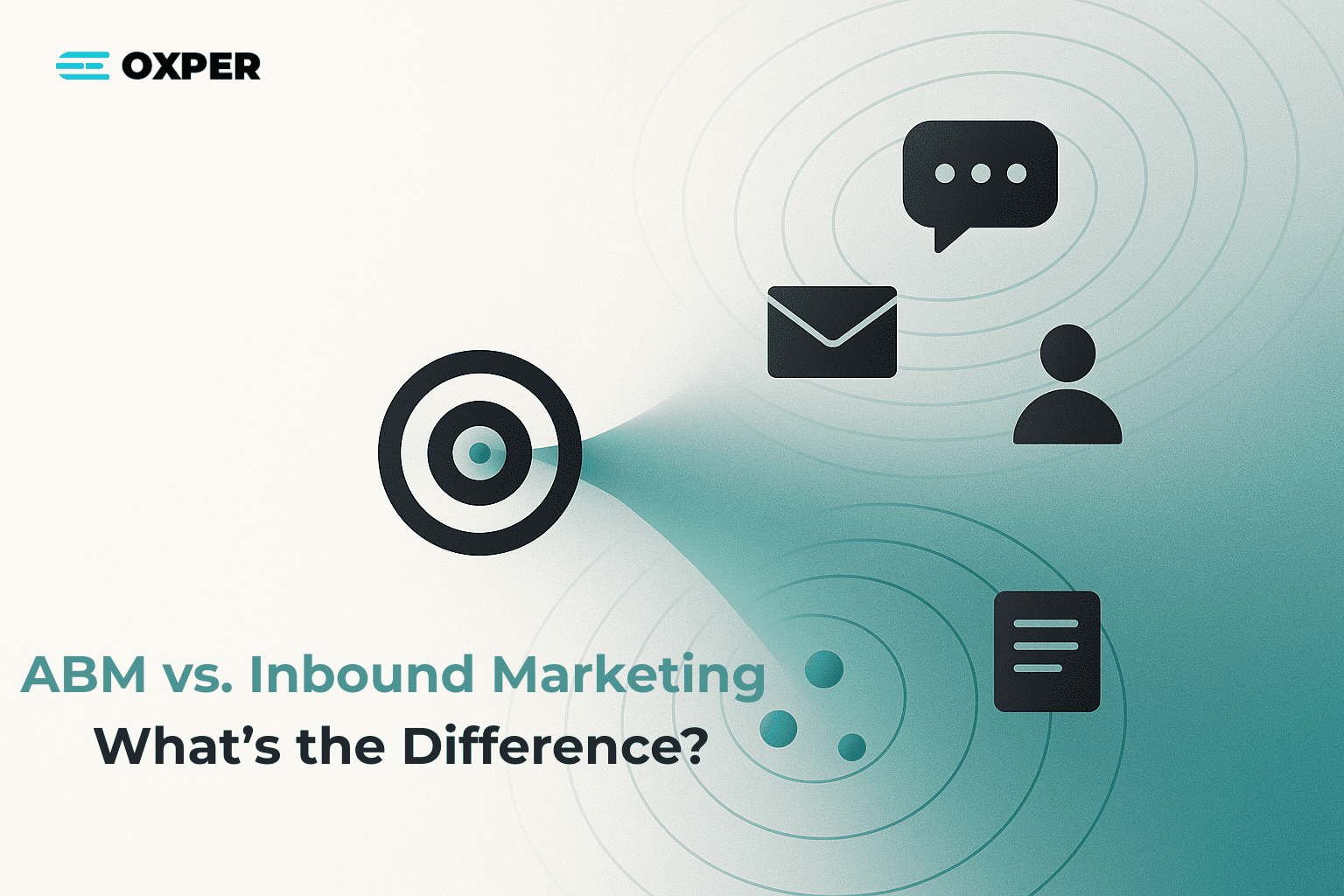B2B marketers often debate whether Account-Based Marketing (ABM) or inbound marketing is the better strategy. The truth? They’re not rivals—they’re complementary. In this guide, we’ll break down the differences between ABM and inbound, highlight their strengths and weaknesses, and show how combining both can fuel sustainable pipeline growth.
What is Inbound Marketing?
Inbound marketing is about attracting prospects by creating content and experiences that naturally draw them to your brand. Instead of pushing your message out, you’re pulling people in with value.
Core inbound tactics include:
- SEO-driven blogs and thought leadership articles
- Gated eBooks, whitepapers, and guides
- Organic social media and community engagement
- Email nurture campaigns
Strengths of inbound marketing:
- Builds long-term brand equity and organic traffic.
- Scales reach efficiently.
- Nurtures leads over time.
Limitations of inbound marketing:
- Attracts a wide audience, but not always ICP-fit accounts.
- Can generate a high volume of MQLs with low conversion to revenue.
- Takes time to deliver results (SEO, brand trust).
Inbound works best for broad awareness and pipeline generation.
What is Account-Based Marketing (ABM)?
Account-Based Marketing flips the traditional funnel on its head. Instead of marketing to a wide pool of leads, ABM starts with a list of high-value target accounts and orchestrates campaigns to win them.
Core ABM tactics include:
- Tiered account segmentation (Tier 1: 1:1 personalization, Tier 2: 1:few, Tier 3: 1:many).
- Personalized content (ROI calculators, executive briefs).
- Targeted LinkedIn ads and display campaigns.
- SDR outreach sequences aligned with marketing plays.
- Executive dinners, events, and direct mail.
Strengths of ABM:
- High precision and focus on accounts that matter.
- Drives stronger alignment between sales and marketing.
- Increases deal size, win rates, and velocity.
Limitations of ABM:
- Requires dedicated resources and orchestration.
- Harder to scale quickly.
- Success depends on tight sales-marketing collaboration.
ABM works best for enterprise and high-value B2B deals.
ABM vs. Inbound Marketing — The Key Differences
Audience Focus
- Inbound: Broad. Anyone actively searching for solutions like yours.
- ABM: Narrow. Handpicked ICP accounts with high revenue potential.
Content Approach
- Inbound: SEO blogs, educational eBooks, webinars for a wide audience.
- ABM: Personalized briefs, account-specific campaigns, ROI tools.
Channels
- Inbound: Organic search, blogs, SEO, email nurtures, social media.
- ABM: Paid LinkedIn campaigns, account-targeted ads, SDR outreach, executive events.
Metrics
- Inbound: Website traffic, MQLs, conversion rates.
- ABM: Account engagement scores, pipeline influenced, deal velocity, ACV.
Sales Alignment
- Inbound: Marketing-led, sales follows up on generated leads.
- ABM: Joint sales-marketing orchestration with shared goals.
Think of inbound as fishing with a net and ABM as spearfishing.
When to Use Inbound Marketing vs. ABM
- Use inbound when:
- Building awareness in a new market.
- Educating the audience about your category.
- Scaling lead generation efficiently.
- Use ABM when:
- Targeting enterprise or mid-market accounts.
- Navigating long, complex buying cycles.
- Needing stronger sales-marketing alignment.
The choice isn’t about inbound or ABM. It’s about when each makes the most sense.
ABM and Inbound Together: The Power of Hybrid
The strongest B2B growth engines don’t rely on just inbound or ABM—they use both in harmony.
- Inbound fuels awareness by attracting broad interest through SEO and thought leadership.
- ABM applies precision by identifying high-value accounts within that audience and engaging them deeply.
Example Hybrid Workflow:
- Inbound captures a pool of leads through a high-value eBook.
- Leads are scored based on ICP fit and buying signals.
- High-fit accounts move into ABM plays (personalized outreach, LinkedIn targeting).
- Remaining leads stay in nurture sequences until they show stronger intent.
This approach ensures you’re not just filling the funnel—you’re filling it with the right accounts.
Real-World Example
Imagine a SaaS vendor that sells enterprise workflow automation:
- Inbound results: Their blog generates 10,000 leads in six months. But 90% are SMBs that don’t match their ICP.
- ABM results: By focusing on 100 Tier 1 enterprise accounts with personalized ABM plays, they secure five multi-year deals worth $2M.
Together, inbound fuels awareness and ABM ensures precision pipeline impact.
Conclusion
ABM vs. inbound marketing isn’t a competition—it’s a partnership.
- Inbound builds reach and trust.
- ABM drives precision and revenue.
- Together, they deliver sustainable pipeline growth.
Forward-thinking B2B companies don’t choose between them. They integrate both into a cohesive demand engine.
Struggling to balance inbound and ABM? At Oxper Martech, we design integrated B2B demand generation strategies and Account-Based Marketing solutions that help companies capture broad awareness while winning high-value accounts. Contact us today to learn how we can help.





